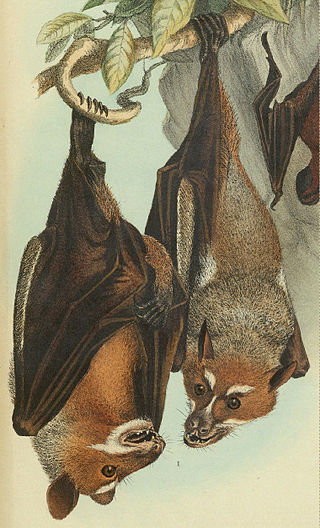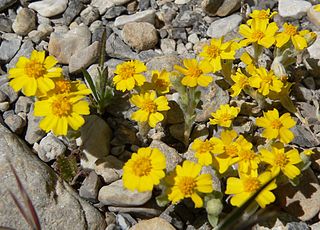
Solanum wallacei, also known as Catalina nightshade, Wallace's nightshade, Northern island nightshade, or wild tomato, is a perennial plant that produces purple flowers, but otherwise resembles a tomato plant. The foliage and purple-black berries are poisonous.

The Moluccan megapode, also known as Wallace's scrubfowl, Moluccan scrubfowl or painted megapode, is a small, approximately 31 cm long, olive-brown megapode. The genus Eulipoa is monotypic, but the Moluccan megapode is sometimes placed in Megapodius instead. Both sexes are similar with an olive-brown plumage, bluish-grey below, white undertail coverts, brown iris, bare pink facial skin, bluish-yellow bill and dark olive legs. There are light grey stripes on reddish-maroon feathers on its back. The young has brownish plumage, a black bill, legs and hazel iris.
The Georgia blind salamander is a species of salamander in the family Plethodontidae. It is endemic to the south-eastern United States where its natural habitats are inland karsts, caves and subterranean habitats. It is listed as "Endangered" by the IUCN and is threatened by habitat loss.

The scarlet-banded barbet is a species of bird in the New World barbet family, Capitonidae. It is endemic to Peru.

The Wallace's or Sulawesi stripe-faced fruit bat is a species of megabat in the family Pteropodidae. It is endemic to Sulawesi and the nearby Togian Islands of Indonesia. Cave paintings resembling these bats have been found in Australia, where bats of this kind are not otherwise known.

Styloctenium is a genus of stripe-faced fruit bat in the Pteropodidae (megabat) family. It comprises the following species:

Eriophyllum wallacei is a North American flowering plant in the family Asteraceae known by the common names woolly daisy and woolly easterbonnets. It grows in the southwestern United States and northwestern Mexico. It may grow in clumps or on short erect stems in sand, rocks, and gravel.

Myoictis or striped dasyure is a genus of marsupials in the order Dasyuromorphia. It is found in New Guinea.

Wallace's dasyure or Wallace's three-striped dasyure is a member of the order Dasyuromorphia. This marsupial carnivore is found in Indonesia and Papua New Guinea. Specifically, it is found on the Aru Islands of the Maluku Province of Indonesia.

Amata wallacei is a species of moth in the family Erebidae first described by Frederic Moore in 1859. It is found on Java, Sumatra, Peninsular Malaysia and Borneo.

Batocera wallacei, common name Wallace's long-horn beetle, is a species of flat-faced longhorn beetle in the subfamily Lamiinae of the family Cerambycidae. The species name honors Alfred Russel Wallace, who discovered this longhorn beetle on the Aru Islands in Indonesia. It was named after him by James Thomson in 1858.
Wallace's tarsier, Tarsius wallacei, is a species of Sulawesi tarsier. It is found in the forests of what is referred to geologically as the neck of Sulawesi where there are two separate populations. It is a small brown arboreal primate of the infraorder Tarsiiformes less than 15 cm (6 in) long.

Graphium wallacei is a butterfly found in New Guinea and the Moluccas that belongs to the swallowtail family.
The Longnose conger is an eel in the family Congridae. It was described by Peter Henry John Castle in 1968, originally under the genus Congrina. It is a marine, deep water-dwelling eel which is known from the Indo-Western Pacific, including Mozambique, Natal, South Africa, Japan, the Philippines, and Indonesia. It dwells at a depth range of 250–500 metres. Males can reach a maximum total length of 55 centimetres.

Heliconius wallacei, the Wallace's longwing, is a butterfly of the family Nymphalidae. It was described by Tryon Reakirt in 1866. It is found from Venezuela and Trinidad to southern Brazil and Peru. The habitat consists of lowland rainforests.

Tmesisternini is a tribe of beetles in the subfamily Lamiinae containing the following genera:

Tmesisternus is a genus of longhorn beetles belonging to the family Cerambycidae, subfamily Lamiinae.
Tmesisternus dubius is a species of beetle in the family Cerambycidae. It was described by Xavier Montrouzier in 1855.
Tmesisternus schaumii is a species of beetle in the family Cerambycidae. It was described by Francis Polkinghorne Pascoe in 1867. It is known from Moluccas, Australia, and the Solomon Islands.

Tmesisternus venatus is a species of beetle in the family Cerambycidae. It was described by James Thomson in 1864.











